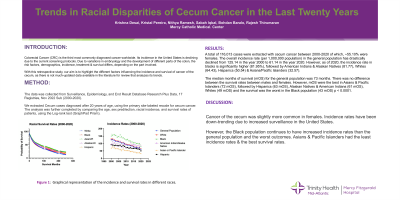Monday Poster Session
Category: Colon
P1622 - Trends in Racial Disparities of Cecum Cancer in the Last Twenty Years
Monday, October 23, 2023
10:30 AM - 4:15 PM PT
Location: Exhibit Hall

Has Audio

Krishna Desai, MD
Mercy Catholic Medical Center
Philadelphia, PA
Presenting Author(s)
Krishna Desai, MD1, Kristal N. Pereira, MD1, Nithya Ramesh, MD2, Sabah Iqbal, MBBS1, Bohdan Baralo, MD1, Rajesh Thirumaran, MD2
1Mercy Catholic Medical Center, Philadelphia, PA; 2Mercy Catholic Medical Center, Darby, PA
Introduction: Colorectal Cancer (CRC) is the third most commonly diagnosed cancer worldwide. Its incidence in the United States is declining due to the current screening protocols. Due to variations in embryology and the development of different parts of the colon, the risk factors, demographics, incidence, treatment & survival differs, depending on the part involved.
With this retrospective study, our aim is to highlight the different factors influencing the incidence and survival of cancer of the cecum, as there is not much-updated data available in the literature for review that analyzes its trends.
Methods: The data was collected from Surveillance, Epidemiology, and End Result Database Research Plus Data, 17 Registries, Nov 2022 Sub (2000-2020). We extracted Cecum cases diagnosed after 20 years of age, using the primary site-labeled recode for cecum cancer. The analysis was further completed by comparing the age, sex predilection, racial incidence, and survival rates of patients, using the Log-rank test (GraphPad Prism).
Results: A total of 116,013 cases were extracted with cecum cancer between 2000-2020 of which, ~55.10% were females. The overall incidence rate (per 1,000,000 population) in the general population has drastically declined from 125.14 in the year 2000 to 61.14 in the year 2020. However, as of 2020, the incidence rate in blacks is significantly higher (81.95%), followed by American Indians & Alaskan Natives (81.77), Whites (64.43), Hispanics (50.54) & Asians/Pacific Islanders (32.57). The median months of survival (mOS) for the general population was 73 months. There was no difference between the survival rates between males and females. However, mOS were the best in Asians & Pacific Islanders (72 mOS), followed by Hispanics (63 mOS), Alaskan Natives & American Indians (61 mOS), Whites (49 mOS) and the survival was the worst in the Black population (43 mOS) p < 0.0001.
Discussion: Cancer of the cecum was slightly more common in females. Incidence rates have been down-trending due to increased surveillance in the United States. However, the Black population continues to have increased incidence rates than the general population and the worst outcomes. Asians & Pacific Islanders had the least incidence rates & the best survival rates.

Disclosures:
Krishna Desai, MD1, Kristal N. Pereira, MD1, Nithya Ramesh, MD2, Sabah Iqbal, MBBS1, Bohdan Baralo, MD1, Rajesh Thirumaran, MD2. P1622 - Trends in Racial Disparities of Cecum Cancer in the Last Twenty Years, ACG 2023 Annual Scientific Meeting Abstracts. Vancouver, BC, Canada: American College of Gastroenterology.
1Mercy Catholic Medical Center, Philadelphia, PA; 2Mercy Catholic Medical Center, Darby, PA
Introduction: Colorectal Cancer (CRC) is the third most commonly diagnosed cancer worldwide. Its incidence in the United States is declining due to the current screening protocols. Due to variations in embryology and the development of different parts of the colon, the risk factors, demographics, incidence, treatment & survival differs, depending on the part involved.
With this retrospective study, our aim is to highlight the different factors influencing the incidence and survival of cancer of the cecum, as there is not much-updated data available in the literature for review that analyzes its trends.
Methods: The data was collected from Surveillance, Epidemiology, and End Result Database Research Plus Data, 17 Registries, Nov 2022 Sub (2000-2020). We extracted Cecum cases diagnosed after 20 years of age, using the primary site-labeled recode for cecum cancer. The analysis was further completed by comparing the age, sex predilection, racial incidence, and survival rates of patients, using the Log-rank test (GraphPad Prism).
Results: A total of 116,013 cases were extracted with cecum cancer between 2000-2020 of which, ~55.10% were females. The overall incidence rate (per 1,000,000 population) in the general population has drastically declined from 125.14 in the year 2000 to 61.14 in the year 2020. However, as of 2020, the incidence rate in blacks is significantly higher (81.95%), followed by American Indians & Alaskan Natives (81.77), Whites (64.43), Hispanics (50.54) & Asians/Pacific Islanders (32.57). The median months of survival (mOS) for the general population was 73 months. There was no difference between the survival rates between males and females. However, mOS were the best in Asians & Pacific Islanders (72 mOS), followed by Hispanics (63 mOS), Alaskan Natives & American Indians (61 mOS), Whites (49 mOS) and the survival was the worst in the Black population (43 mOS) p < 0.0001.
Discussion: Cancer of the cecum was slightly more common in females. Incidence rates have been down-trending due to increased surveillance in the United States. However, the Black population continues to have increased incidence rates than the general population and the worst outcomes. Asians & Pacific Islanders had the least incidence rates & the best survival rates.

Figure: Graphical representation of the incidence and survival rates in different races.
Disclosures:
Krishna Desai indicated no relevant financial relationships.
Kristal Pereira indicated no relevant financial relationships.
Nithya Ramesh indicated no relevant financial relationships.
Sabah Iqbal indicated no relevant financial relationships.
Bohdan Baralo indicated no relevant financial relationships.
Rajesh Thirumaran indicated no relevant financial relationships.
Krishna Desai, MD1, Kristal N. Pereira, MD1, Nithya Ramesh, MD2, Sabah Iqbal, MBBS1, Bohdan Baralo, MD1, Rajesh Thirumaran, MD2. P1622 - Trends in Racial Disparities of Cecum Cancer in the Last Twenty Years, ACG 2023 Annual Scientific Meeting Abstracts. Vancouver, BC, Canada: American College of Gastroenterology.
